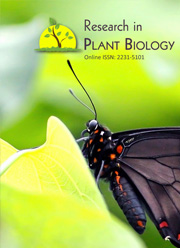Isolation of Xylan degrading enzyme from Trichoderma spp.
Keywords:
Solid state Fermentation, Submerged Fermentation, Trichoderma spp, XylanasesAbstract
The use of hemicellulolytic enzymes has recently attracted considerable interest asa substitute for chlorine chemicals in pulp bleaching in view of the environmental concerns. The cellulase free xylanase from microorganisms has been isolated and tested for bleaching activity, giving rise to a new concept of biobleaching. In this aspect, the present study aims to check the tolerance of Trichoderma spp., a biological controllingagent, in perceptive to the production of xylanase enzyme. The strains were isolated fromthe environmental soil samples taken from the effluent treatment area. The organismswere subjected to growth at various pH conditions. The resistant strains T-1 and T-2 to adifferent pH were further isolated and grown by on selective xylan-agar medium.Maximum growth of the organism was found at 48h under submerged condition in xylancontaining enriched medium. The organisms produce an extra cellular xylanase that had alow molecular weight and optimal working temperatures. Further proposed studiesinclude the bleaching activity of the enzymes and comparison of the industrialapplication with the commercially available enzymes. The trials can also be carried out inpaper processing industry and the bleaching sequences can be analyzed for efficacy ofbleaching and pre bleaching.Downloads
Download data is not yet available.
Published
15-08-2011
How to Cite
Mphan, G., Guhankumar, P., & Balakrishnan, V. (2011). Isolation of Xylan degrading enzyme from Trichoderma spp. Research in Plant Biology, 1(3). Retrieved from https://www.updatepublishing.com/journal/index.php/ripb/article/view/2578
Issue
Section
Articles



 .
. 